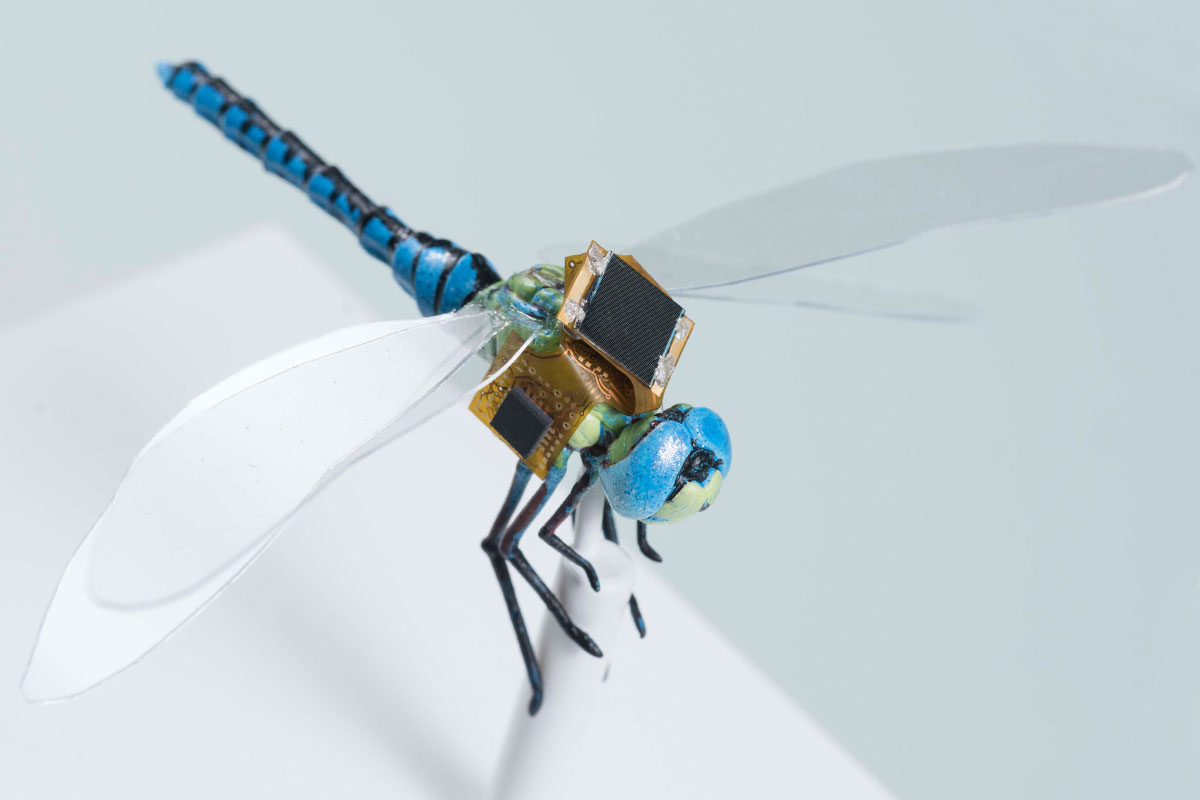Draper creates insect robots as part of the DragonflEye project.

The smallest unmanned aerial vehicles are similar to insects in many ways, but cannot surpass them in maneuverability and efficiency. It will take a very long time before scientists manage to create a universal soldier who combines the technological capabilities and natural abilities, the insect robot. Over the past few years, researchers have learned to control large insects using electrical implants - a kind of brute force method with limited real benefits.
Now scientists from the Howard Hughes Medical Institute with the Draper Laboratoryhoping to overcome the limitations by creating a cyborg dragonfly, which will combine "miniature navigation, synthetic biology and neurotechnology." By controlling dragonfly, laboratory engineers are developing a way to genetically modify the nervous system of insects so that they can respond to light impulses. As soon as they succeed, an approach known as optogenetic stimulation will allow the dragonfly to carry cargo, conduct external surveillance and even help the bees to pollinate the plants better.
But why a dragonfly? They are spread all over the world and in addition are very hardy and agile flyers for their small size. Further work may expand the use of the control system for other insects, including important pollinators.
The DragonflEye project is a collaboration of scientists from the Draper Laboratory and the Howard Hughes Medical Institute. The team develops tiny optical fibers that can activate special flight control neurons using light pulses. Traditional fiber is too hard to wrap around the tiny dragonfly nerve trunks, so scientists have created an innovative, flexible material for this purpose. This allows you to significantly increase the functionality and significantly reduce the weight and size of the entire control system.
In addition, a group of scientists managed to pack all the electronics in a small “backpack”. This means that small insects like bees or dragonflies will be able to fly with it. It was also possible to develop such a small “backpack” due to the use of solar panels to collect energy, minimizing the need for batteries. It has a built-in control and navigation system, so fully autonomous navigation is possible outside the controlled environment. This system is the first generation, which allows you to control insects using optogenetic stimulation .

Backpack components close up
The researchers studied how special “steering” neurons control the direction of flight of the dragonfly. Such neurons are a type of interneurons that are neither sensual nor motor. Scientists believe that the interneurons give the "steering" commands down the neuromuscular connections that coordinate the movement of the muscles of the wings and maintain a stable flight. They will act pointwise, without inadvertently activating nearby neurons and muscles through optogenetics. This approach will allow scientists to activate individual neurons with light, which could not be done with electricity.
In previous designs, electrodes were used to control the muscles of the insect and force it to do what was needed. The engineers of Draper Laboratory decided to use a more delicate approach, using the technology of optogenetics - activation of certain neurons using light pulses. Neurons that are responsible for the controllability of an insect can also act as a bridge between the sensors of a dragonfly and its muscles. In this way, more reliable control over the movements of the insect can be achieved.
Regular dragonflies weigh about 600 milligrams and migrate over long distances. Mechanical aircraft of comparable size are much less effective in lifting weights, stabilizing flight, and conserving energy. This inefficiency creates a fundamental problem: the technology can carry only very small sources of energy, which means that it is adapted only for short-term flights. DragonflEye system does not require a power source for the flight - only for navigation. It can work almost infinitely because of the ability of insects to get energy from food and the ability of the navigation system to collect energy from the environment.
The team is now focused on developing methods for delivering dragonfly-specific genes to create special control neurons that are sensitive to light. At the next stage of development, a team of researchers and engineers plans to reduce the size and weight of the DragonflEye system, creating a custom integrated single-chip system . Thus, smaller insects can carry this “backpack”.
Previous attempts to control the flight of insects have been made.for larger insects - various bugs and locusts, so that they can lift relatively large electronics systems that weigh up to 1.3 grams on their bodies. Navigation and the ability to send commands to control the flight without wires are not built into these systems. Then the scientists replaced the input signals to control the flight, directly stimulating the neurons and the muscles controlling the wings. The problem with this approach is that insects adapt and stop paying attention to sensory information that is not consistent with other senses. Such a system impairs the muscle control necessary for a stable flight. It also uses electrical stimulation, which activates not only the neurons, but also the muscles near the electrodes.
Tracking insects and small animals will allow researchers to better understand their behavior in the wild, observe environmental changes and guide policy development to protect important ecosystems. In addition to tracking, the system offers miniature technology for equipping a large number of insects with environmental sensors.
